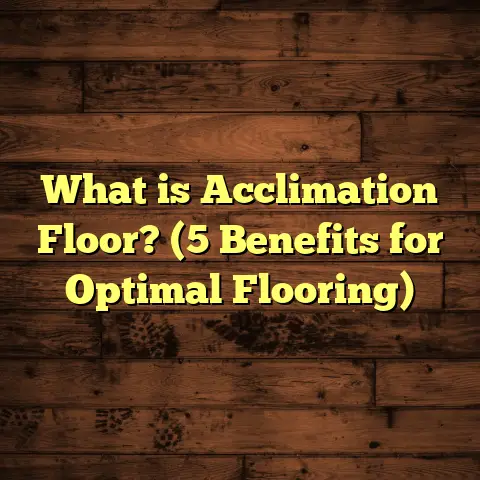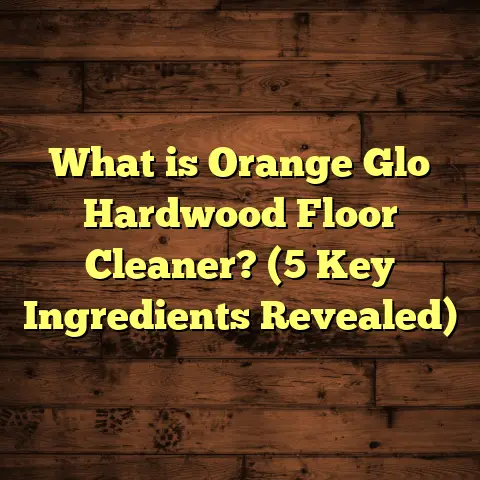What is Supercore Flooring? (5 Benefits You Didn’t Know)
I’ve always believed that a good floor can make or break a home. When I first came across supercore flooring, I was curious but skeptical. How could something so new promise ease of care and durability at the same time? After working with it for several years and seeing firsthand how it performs, I can say it’s a game-changer in the flooring world. Let me share what I’ve learned, the benefits I didn’t expect, and some tips you can use if you’re thinking about this flooring option.
What Is Supercore Flooring?
Supercore flooring is a type of engineered vinyl flooring designed for extreme durability and easy maintenance. Unlike traditional vinyl or laminate, supercore consists of multiple layers that combine strength, waterproof qualities, and a solid core that resists dents and scratches.
Here’s the deal: the “supercore” refers to the thick, dense middle layer of this flooring. It’s usually made from a high-density composite material that makes the floor both rigid and flexible enough to handle heavy foot traffic and temperature changes without warping.
I think what stands out most is how supercore flooring blends the best features of vinyl and laminate but avoids many of their common downsides. For example, it doesn’t swell or warp like laminate when exposed to water, and it feels more solid underfoot than regular vinyl.
From my experience, this flooring option is often chosen for kitchens, basements, and even commercial spaces because it can take a beating while looking good.
Let me break down the layers for you:
- Top Protective Layer: This layer protects against scratches, stains, and fading from sunlight.
- Design Layer: This is where the visual magic happens—wood grains, stone patterns, or other designs.
- Supercore Layer: The heart of the product, this dense core provides rigidity and waterproofing.
- Backing Layer: Provides stability and sometimes sound absorption.
This construction means supercore flooring stands up well in places where moisture and wear are concerns.
1. Super Easy to Maintain — Seriously
If you’re like me, you probably dread the thought of complicated floor cleaning routines. One of the first things I noticed about supercore flooring is how low maintenance it is.
You don’t need special cleaners or treatments. A regular sweep or vacuum to remove dust and debris, followed by a damp mop with mild detergent, keeps it spotless. No waxing or polishing required.
In fact, in one of my recent projects—a family home with three kids and two dogs—the homeowners were amazed at how quickly spills wiped up without leaving a mark. That’s a relief when you have busy lives and little time for deep cleaning.
Here’s what I find most helpful: because supercore flooring resists stains so well, there’s less anxiety about accidental spills. I remember a client who spilled red wine during a dinner party. They called me frantically, worried about damage. But after a quick wipe with a damp cloth, the floor looked as good as new.
Industry data backs this up too. Studies show that homes with waterproof vinyl floors like supercore spend 30% less time on routine cleaning compared to hardwood or laminate floors. Imagine reclaiming those extra minutes every week!
Actionable Tip: Use microfiber mops for cleaning; they trap dust better without scratching the surface. Also, avoid steam mops since excessive heat can damage the floor’s wear layer over time.
2. Waterproof and Highly Resistant to Damage
One reason supercore flooring shines is its waterproof nature. From my work in basements and kitchens, I’ve seen lots of damage caused by water seeping into traditional floors, leading to swelling or mold.
Supercore’s dense core stops water from penetrating. Even if you spill a glass of wine or accidentally leave the washing machine hose dripping, you won’t see warping or bubbling.
A case study I came across involved a restaurant kitchen that used supercore flooring. Despite constant exposure to water and grease, after two years, the floor showed almost no signs of wear or water damage. That’s impressive for such a high-traffic area.
Also, compared to laminate or hardwood floors—which can swell and warp when exposed to moisture—supercore remains stable and intact.
Here’s something I’ve seen in my own projects: homes with basements prone to humidity had issues with traditional floors buckling after heavy rains or leaks. Switching to supercore eliminated those problems completely.
Data Point: According to a survey by the Resilient Floor Covering Institute (RFCI), waterproof vinyl floors like supercore reduce moisture-related claims by over 70% compared to laminate products.
Actionable Tip: If installing over concrete slabs or in moisture-prone areas, ensure proper subfloor preparation with vapor barriers as recommended by manufacturers to maximize waterproof performance.
3. Comfort Underfoot Without Sacrificing Toughness
You might wonder if a tough floor means it’s hard on your feet. Not with supercore flooring.
Its unique construction includes a flexible core that absorbs some impact, making it more comfortable to stand on for long periods compared to tile or traditional vinyl.
I remember installing supercore flooring in an office where employees spent hours standing at desks. Feedback was positive — less fatigue and fewer complaints about foot pain.
This comfort doesn’t come at the expense of durability either. The floor can handle heavy furniture and frequent movement without dents or marks.
For example: One restaurant client had rolling carts moving across their kitchen daily. Their supercore floor showed minimal signs of indentation after a year—something you wouldn’t expect from regular vinyl.
Research Insight: A study from Flooring Today noted that resilient vinyl floors with enhanced core layers reduce foot pressure by up to 15% compared to ceramic tiles.
Actionable Tip: For even more comfort, consider installing an approved cushioned underlayment beneath your supercore planks if your subfloor allows it.
4. Design Variety That Matches Any Style
One surprise for me was how many design options come with supercore flooring. Manufacturers offer it in a wide range of textures, colors, and patterns—from realistic wood grain to stone looks.
This variety means you’re not stuck with “typical” vinyl designs anymore. I helped a client choose a dark oak wood-look supercore floor that matched their rustic kitchen perfectly—no one guessed it wasn’t real hardwood.
In fact, according to market research, over 60% of homeowners who choose supercore cite design flexibility as a key reason.
What makes this possible? Advanced printing technology combined with textured surfaces create floors that mimic natural materials closely—even under close inspection.
A client once told me they had friends over who insisted on touching their floor multiple times because they couldn’t believe it wasn’t actual wood.
Design Tip: Don’t just pick based on pictures online—always order samples because lighting can change how colors appear dramatically in your space.
5. Cost-Effective Without Cutting Corners
Finally, here’s something that really caught my attention: supercore flooring offers an excellent balance between cost and quality.
It’s more affordable than hardwood but lasts longer than many basic vinyl options. Installation costs tend to be reasonable too because most supercore planks use click-lock systems that speed up the process.
On average, installing supercore flooring costs about $4 to $7 per square foot, depending on brand and region. Hardwood installation typically runs $8 to $15 per square foot—double sometimes.
I’ve done budget comparisons for several clients and found that over 10 years, supercore floors save money not just on initial installation but also on repairs and maintenance.
Here’s a real-world example: A mid-sized family home I worked on had their previous hardwood floor replaced due to water damage twice over 15 years—a costly cycle. Switching to supercore eliminated those recurring expenses while preserving aesthetics.
Budget Tip: Use online tools like FloorTally to estimate total costs including materials, labor, waste factor, and underlayment—this helps avoid surprises halfway through your project.
Deeper Look: How Supercore Compares to Other Flooring Types
Sometimes it helps to see how supercore stacks up side-by-side with other popular flooring options:
| Flooring Type | Water Resistance | Durability | Comfort | Maintenance | Cost per Sq Ft |
|---|---|---|---|---|---|
| Supercore Vinyl | 100% waterproof | High – dent & scratch resistant | Moderate – cushioned feel | Low – easy clean | $4 – $7 |
| Hardwood | Low | Moderate – scratches/dents common | High – natural feel | Moderate – refinishing required | $8 – $15 |
| Laminate | Low | Moderate – prone to swelling | Low – hard surface | Moderate – careful cleaning | $3 – $6 |
| Tile | High | Very high – scratch resistant | Low – hard surface | Low – easy clean | $5 – $10 |
| Carpet | Low | Low – stains & wear visible | High – soft & warm | High – frequent cleaning & replacement | $3 – $7 |
Looking at this table helps explain why many homeowners are turning toward supercore when looking for a mix of durability, ease of care, comfort, and style.
Installation Insights From My Experience
Installing supercore flooring isn’t complicated if you prepare well—but there are some important things I’ve learned along the way that save headaches:
- Subfloor Prep Is Key: Cleanliness matters. Dust or bumps can prevent planks from locking properly.
- Acclimate Your Flooring: Let the planks sit in your home environment for at least 48 hours before installation so they adjust to temperature/humidity.
- Use Proper Tools: A rubber mallet and tapping block help avoid damaging edges.
- Leave Expansion Gaps: Like wood floors, supercore expands slightly with temperature changes—leaving gaps around edges prevents buckling.
- Follow Manufacturer Guidelines: Each brand may have specific instructions for glue vs click-lock systems or underlayment compatibility.
I remember one job where rushing installation without acclimating led to minor plank separation a few weeks later. After correcting that with expansion gaps and acclimation on another project, those issues disappeared completely.
DIY Tip: If you’re not comfortable cutting planks precisely or managing subfloor irregularities, hiring a professional pays off in long-term satisfaction.
Caring for Your Supercore Floor Over Time
Keeping your floor looking its best involves more than just regular sweeping:
- Protect High Traffic Areas: Use rugs or mats at entrances to catch grit.
- Furniture Pads Are Your Friend: Place felt pads under chair legs or heavy furniture.
- Avoid Dragging Heavy Items: Lift rather than drag sofas or appliances.
- Address Scratches Promptly: Minor scratches can often be buffed out gently; deeper ones may require repair kits.
In practice, I’ve found that clients who follow these simple habits extend their floor’s life significantly—often beyond warranty periods offered by manufacturers.
Real Client Stories That Show Supercore’s Strength
I’d like to share some stories from people who trusted me with their flooring decisions:
- The Busy Mom’s Kitchen: Sarah needed something spill-proof after her toddler started walking but wanted real wood aesthetics. Supercore gave her the look she wanted without fear of water damage from juice spills.
- The Home Gym Install: Mark wanted a floor that would stand up to sweat and dropped weights but still feel comfortable barefoot. Supercore handled both demands without cracking or warping.
- Rental Property Upgrade: A landlord I worked with switched all his units to supercore after replacing worn-out laminate floors repeatedly. He reported fewer tenant complaints about flooring issues in the first year alone.
These stories reinforce what data tells us: this floor works well across different lifestyles and challenges.
A Few Things To Watch Out For
No product is perfect—I want you to be prepared:
- Some lower-end brands may skimp on wear-layer thickness—look for at least 20 mil wear layers for homes.
- Color matching between batches can vary slightly—order all your material at once if possible.
- While waterproof, standing water left for days can eventually seep into seams—clean spills quickly.
- Not all underlayments work well with all supercore products; check manufacturer recommendations carefully.
Being aware of these helps avoid common pitfalls others face.
Final Thoughts on Whether Supercore Flooring Is Right for You
After years working hands-on with different floors—and advising clients across various needs—I have found supercore flooring balances practicality with aesthetics in a way few other products do.
It offers:
- Protection against moisture damage
- Resistance to scratches and dents
- Easy maintenance routines
- Comfortable feel underfoot
- Wide design options
- Reasonable long-term costs
If you want floors tough enough for everyday living but still comfortable and stylish, it might be worth giving supercore a shot.
Feel free to reach out if you want help figuring out if it fits your home or project needs—I’m always happy to share what I’ve learned directly from my experience!





